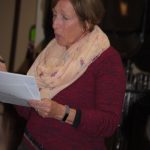
Photo courtesy Tom Nolan
Tom Nolan, JPL public outreach speaker, came to Pasadena’s Jet Propulsion Laboratory during the 1997-98 El Niño. As a marine biologist, he has watched how climate-change cycles have spawned ocean-influenced weather patterns.
He will be guest speaker at AstroCamp on Thursday, Nov. 12, discussing the upcoming El Niño, predicted to equal or eclipse the 1997-98 event. Nolan has experienced developing weather patterns from below, within and above the oceans he has monitored. He has participated in research cruises in French Polynesia, Hawaii, the Aleutian Islands, Mexico and the University of Southern California’s marine laboratory on Catalina Island. He also is JPL’s operations engineer and in that role has commanded instruments on multiple Earth-observing spacecraft in addition to instruments on the Opportunity rover on Mars.
He also has served as operations engineer, preparing, sequencing and up-linking commands to the Multi-angle Imaging Spectro-Radiometer satellite instrument mapping Earth’s climate in 3-D. “Satellite oceanography allows observation and mapping from space as Earth weather patterns develop,” said Nolan.
Currently, Nolan is JPL’s science scheduler, allotting NASA satellite monitoring time for observation of changes on the Earth’s surface due to natural hazards.
Nolan will discuss the possibilities for the coming El Niño as part of an overall discussion of climate change. Asked how weather prediction has changed since 1997-98, Nolan noted, “We now have better tools, more satellites and better satellite imaging capabilities than we did then, with far greater degrees of resolution. We can see pockets of warm water in finer detail and down to specific areas, to help local forecasting.”
Nolan will discuss the role of long-term climate change as a driver of the coming El Niño. “The water that we’ll be getting comes from Indonesia,” he noted. “Our drought relief will be their drought. The jet stream will move their monsoon season from there to here.
“And our concern, as scientists and people, is how to help those who are most adversely affected. It’s likely that poor people [in at risk areas] will get hammered a lot more than those who are wealthy.”
Nolan said scientists are seeing evidence of the shift of warm water in the Pacific eastward by indicators such as the yellow-belly sea snake surfacing on California beaches. The highly poisonous snake is usually found in tropical climates and was last seen in California 30 years ago. “Kelp is gone from the California coast,” said Nolan. “It can’t handle warm water. Those ecosystems are gone for now.”
Nolan enjoys his role as outreach educator for JPL. “I take the science developed and present and interpret it for general audiences,” he said. “El Niño: Good Boy or Bad Boy’ will be about what we can expect from coming climate patterns and weather conditions and how we can best prepare. I’ll also talk about other areas and how they’ll be affected since this is not just about us. Another consideration is if what we’re seeing is a new ‘normal.’”
Nolan speaks at AstroCamp’s Star Gallery from 6 to 7 p.m. There is no charge for this event.










